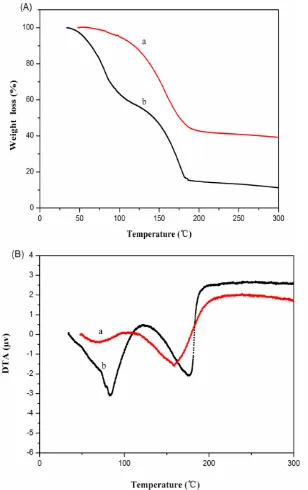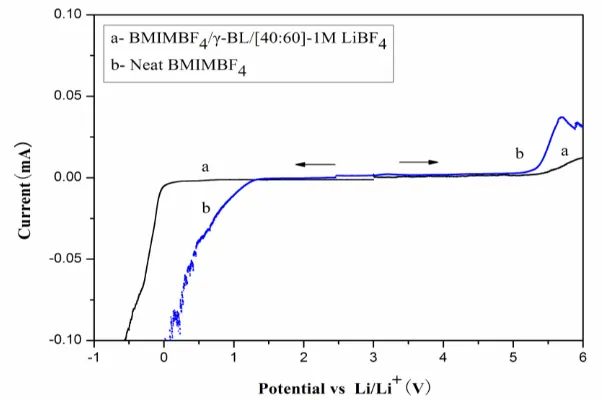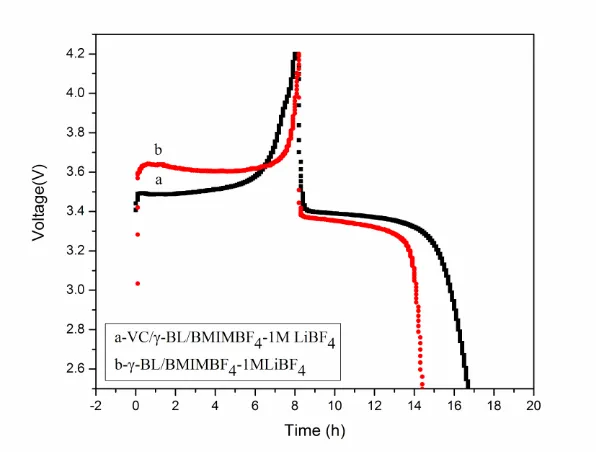Int. J. Electrochem. Sci., 7 (2012) 1688 - 1698
International Journal of
ELECTROCHEMICAL
SCIENCE
www.electrochemsci.org
BMIMBF
4Ionic Liquid Mixtures Electrolyte for Li-ion
Batteries
Hongmei Wang1,2, Suqin Liu1,*, KelongHuang1, Xiongge Yin1, Younian Liu1, Sanjun Peng2 1
College of Chemistry and Chemical Engineering, Central South University, Changsha410083, China 2
School of Chemical & Biological Engineering, Changsha University of Science & Technology, Changsha 410114, China
*
E-mail: wanghm123@126.com
Received: 23 December 2011 / Accepted: 14 January 2012 / Published: 1 February 2012
The ionic liquid (IL) 1-butyl-3-methyl-imidazolium tetrafluoroborate (BMIMBF4) was prepared on basis of 1-methylimidazole, and was combined with γ-butyrolactone (γ-BL). The BMIMBF4/γ-BL mixture was used as Li/LiFePO4 cell electrolyte. The viscosities, conductivities and thermal stability of the mixtures were investigated. The results indicates that BMIMBF4/γ-BL (40/60) -based electrolyte has high conductivity (10.76 mS/cm) at 25 °C, low viscosity and high thermal stability. In addition, linear sweep voltammetry test of BMIMBF4/γ-BL (40/60)-1 M LiBF4 demonstrated that the electrochemical window was 5.3 V. Moreover, cyclic voltammetry and charge–discharge of BMIMBF4/γ-BL (40/60)-1 M LiBF4 electrolyte have been investigated in Li/LiFePO4 cells. The addition of vinylene carbonate (VC) significantly improved the capacity and cyclic performance of the cell. The initial discharge capacity of Li/LiFePO4 in optimized mixture electrolyte with VC, was 144.2 mAh/g at a current density of 0.1 mAh/g, 40 mAh/g higher than that of the without. The cell with the additive had a 140.3 mAh/g discharge capacity without any considerable fading during 20 cycle numbers.
Keywords: Li-ion battery; Ionic liquid;1-butyl-3-methyl-imidazolium tetrafluoroborate (BMIMBF4); Vinylene carbonate; LiFePO4
1. INTRODUCTION
growth of dendrites during cycling, which causes non-reversibility and even safety hazard [2]. Another safety concern is the high flammability and high vapor pressure of conventional organic solvents commonly used in lithium ion batteries nowadays. Under such background, ionic liquids (ILs) have aroused much attention to be used as safe electrolytes in lithium-ion batteries because of its excellent thermal stability, negligible volatility and non-flammability, and wide electrochemical window[3-8].
However, pure ionic liquids are highly viscous and exhibit relatively low conductivities, which impedes their application in lithium-ion batteries. It is found that the addition of organic dipolar diluents, such as acetonitrile (ACN), ethylene carbonate (EC), diethylene carbonate (DEC) and γ-butyrolactone (γ-BL), to neat ionic liquid is a good way to decrease the viscosity of neat ionic liquids[9-14]. Among them, the aprotic solvent γ-BL has a sufficiently high dielectric constant (39.1 at 25°C), a relatively low viscosity(1.75 mPa·s at 25 °C), a low fusion point (-45 °C) and a high boiling point (204 °C) [15], the mixed γ-BL and ILs electrolytes can improve both the performance and thermal stability[11,16]. Unfortunately, reversible electrochemical plating and stripping (cycling) of lithium is frequently complicated by the electrochemical instability of the IL moieties at Li+ reduction potentials. Most of the systems reported rely on the formation of a solid electrolyte interphase (SEI) to protect the IL from the reactive lithium metal surface. Addition of an appropriate additive,vinylene carbonate (VC),to IL electrolytes has been shown to facilitate or improve lithium cycling while protecting the IL from reduction at the electrode[8,17-23].
To our best knowledge, the mixed IL electrolyte, 1-butyl-3-methylimidazoliumtetrafluroroborate (BMIMBF4) and γ-BL containing LIBF4 with VC or without used in Li/LiFePO4 batteries has not been reported. Herein, we reported the study of the viscosities, conductivities, thermal stability and the electrochemical properties of the mixed IL electrolyte. The aim of this investigation was to look for a safety efficient electrolyte.
2. EXPERIMENTAL
2.1. Preparation of ionic liquid BMIMBF4
128.6 ml (1.19 mol) bromobutane and 79.0 ml (0.99 mol) 1-methylimidazole were added to a round-bottomed flask, stirred at 70 °C for 72 h. After that the reaction mixture was separated to eliminate the excess bromoalkane, giving 1-butyl-3-methylimidazolium bromide (BMIMBr). Then, BMIMBr and NaBF4 with equivalent molar amounts were mixed in acetone, stirred at 25 °C for 24 h. After that the reaction mixture was filtered to eliminate precipitated bromide salt (NaBr). At last, the obtained solvent was evaporated to yield BMIMBF4 [24].
And the organic layer containing BMIMBF4 was evaporated to remove CH2Cl2. Finally, the purified BMIMBF4 was obtained after drying under vacuum at 120 °C overnight [25–26].
2.2. Measurement procedures and apparatus
Ionic liquid BMIMBF4 and γ- BL (purity > 99.99%, Aldrich) were treated with activated molecular sieve. The conductivity measurements were performed using a DDS-307 conductometer (Shanghai, China) and a conductivity cell equipped with a platinum (Pt) electrode. Prior to each test, the cell constant was calibrated in 0.01 mol/L KCl solution. Viscosity measurements were performed using a Brookfield DV-Ⅲ+ Rheometer-lamina viscometer.
The thermal stability of electrolytes was conducted on Thermal Analysis FRC/T-2, a type of simultaneous thermal gravimetric analysis (TGA) and differential thermal analysis(DTA) equipment under nitrogen at a heating rate of 10 °C min−1 from 20 °C to 400 °C. The electrolytes were prepared by dissolving 1 M LiBF4 into the mixed solvents. The conventional organic electrolyte, ethylene carbonate(EC)/diethylene carbonate(DEC)/dimethyl carbonate(DMC)-1 M LiPF6, was used as the reference electrolyte.
Linear sweep voltammetry (LSV) measurements were conducted using CHI660B Electrochemical Workstation (Shanghai, China) in a three-electrode cell with Pt as the working electrode, lithium foil as the counter and reference electrodes under argon atmosphere.
Battery tests were carried out with coin-type cells. Electrolytes consisted of a solution of 1 M LiBF4 in the optimized mixture with VC or without. The cathode was made up of LiFePO4, acetylene black, and polytetrafluoro ethylene (PTFE) in the weight ratio of 85:10:5. The slurry was coated onto a stainless steel current collector (Ø 9 mm). The electrode was pressed at 10 MPa then dried at 120 °C for 12 h in a vacuum oven. The CR2016 coin cells were assembled in an argon-filled glove box (Mbraun, Germany) with a lithium foil (Ø14 mm) as the counter electrode and a Celgard polyethylene/polypropylene membrane as the separator.
Cyclic voltammetry (CV) tests were also carried out using CHI660B Electrochemical Workstation. The galvanostatic charge-discharge was performed by a battery test system (LAND CT2001A, China).
3. RESULTS AND DISCUSSION
3.1. Ionic conductivity and viscosity
[image:4.596.150.448.228.437.2]
addition of the same volume γ-BL to neat BMIMBF4, the conductivity is markedly increased from 3.3 to 13.99 mS/cm. The result indicates that addition of γ-BL to neat ionic liquid BMIMBF4 is an efficient way to increase the ionic conductivity of neat ionic liquids. Fig. 1. also shows that the ionic conductivities of the mixture enhanced with increasing the temperature. As everyone knows, the viscosity of solution affects on the rate of mass transport. For further demonstration, the influence of rate (BMIMBF4/γ-BL) on the viscosity and conductivity of mixture has been studied (Fig. 2). When the IL in the mixtures increases from 0 to 40%, the conductivity rises as one would expect if the “salt” (IL) concentration increases by adding it to the organic solvent.
Figure 1. Variations of conductivity of BMIMBF4, γ-BL and BMIMBF4/γ-BL mixture vs. temperature
[image:4.596.138.461.501.689.2]
On the other hand, additions of IL also increase the viscosity but not so steeply. Around 40% IL in the mixture, further increases of IL lead to decreases in conductivity because there is not sufficient organic solvent available to “solvate” all the IL present, and conductivity approaches that of pure IL. Correspondingly, and not unexpected, there is a steep rise in viscosity of the mixtures with increasing IL fraction. The most conducting mixtures expressed in volume fraction is BMIMBF4/γ- BL (40/60), which agrees with the results reported by M. Diaw[10].
The ionic conductivities of three electrolytes containing LiBF4 versus the temperature were also measured (Fig.3). Fig.3 indicates the BMIMBF4/γ-BL (40/60, v/v) electrolyte has the highest ionic conductivity, which is 10.76 mS/cm at 25 °C. The ionic conductivity of the BMIMBF4-1M LiBF4 electrolyte is lower than that of γ-BL-1M LiBF4, due to the high viscosity of BMIMBF4.
[image:5.596.132.468.265.553.2]
Figure 3. Ionic conductivities vs. temperature for different electrolytes
3.2 Thermal stability
below 125 °C, and there is a broad endothermic from 125 °C to 200 °C, attributed to the vaporization of strongly solvated γ-BL molecules [11]. However, Fig. 4B (b) displays two endothermic peaks, the initial mass loss below 100 °C is due to the release of DMC and DEC [2]; The endothermic peak at about 200 °C corresponds to the release of EC (243 °C, boiling temperature) and some thermal decomposition products (HF, PF5 ) of LiPF6 [26]. This thermal result reveals that the mixed IL electrolyte shows a greater thermal stability.
[image:6.596.147.455.188.678.2][image:7.596.147.448.103.303.2]
3.3. Electrochemical windows at a Pt electrode
Figure 5. Linear sweep voltammetries of the mixed IL electrolyte and neat BMIMBF4 at 25 °C
Electrochemical window is a very important parameter in electrolytes, the linear sweep measurement of the mixed IL electrolyte and neat BMIMBF4 on Pt electrode was measured Li foil as the counter electrode and reference electrode, at a scanning rate of 5mV/s. Fig. 5 shows the result.
From Fig. 5a, the anodic and cathodic limit potential was at 0 V and 5.3 V vs. Li/Li+, respectively. That is, the electrochemical window of the optimized electrolyte (BMIMIBF4/ γ-BL– 1MLiBF4) was over 5.3V whereas the neat BMIMBF4 was over 4.2 V(Fig. 5b), Addition of LiBF4 enlarges voltage limits of neat BMIMBF4 [27-28], due to the higher cathodic stability in the presence of lithium salt may be a passivation process with the participation of Li ions and trace water in the formation of the passivating surface films comprising Li2O, LiOH and LiF on the electrode surface [17]. The result demonstrates that the mixed IL electrolyte could act as a medium for the Li ion batteries.
3.4 Battery tests
Figure 6. Cyclic voltammetry curves of Li/LiFePO4 cells in different electrolytes at 0.1 mV/s.
The cause may be that the additive VC (1.17 V vs. Li/Li+) has higher reductive potentials than the electrolyte solvents (γ-BL, 1.15V vs. Li/Li+, and BMIMBF4, 1.0 V vs. Li/Li+) [29-30]. Prior to electrochemical reduction of the electrolyte solvents, the additive is preferably reduced to form an insoluble solid product, which subsequently is covered onto the surface of Li foil as a preliminary film to deactivate catalytic activity.
[image:8.596.153.447.73.304.2] [image:8.596.150.448.456.682.2]
Figure 8. Cyclic performance of Li/LiFePO4 cells in different electrolytes
Therefore, VC additive provides the better efficient SEI in the mixture electrolyte and could improve the reversible electrochemical reaction[8,23]. Fig. 7 and Fig. 8 display that cycling behaviour of Li/LiFePO4 cells in different electrolyte was performed at a current density of 17mA/g (0.1C) between 4.2 V and 2.5 V. The first charge–discharge curves results were summarized in Fig.7. The BMIMBF4 based electrolytes showed one charge and discharge plateau around 3.4 V. Moreover, the voltage difference between charge and discharge plateaus was smaller when the mixed IL electrolyte contained VC, suggesting that addition VC makes the process of lithium deposition and dissolution smooth.
Fig. 8 also indicated the effect of VC addition was even more significant for the cyclic performance. The initial discharge capacity of the cell with VC was 144 mAh /g. However, the initial reversible capacity (104 mAh/g) and columbic efficiency (76%) without VC, became smaller, which is consistent with CV test (Fig. 6). After 10 cycles, the discharge capacity of the cell containing VC electrolyte was 142 mAh/g, and higher than that of the electrolyte without VC (54 mAh/ g). Moreover, the capacity loss of the cell containing VC was only 3.5% after 20 cycles.
4. CONCLUSIONS
[image:9.596.153.445.73.270.2]
electrolyte towards lithium anodes and enhanced the formation of SEI. Accordingly, the Li/LiFePO4 cell with γ- BL/BMIMBF4 (60/40)-1M LiBF4 containing VC had a high discharge capacity of 140.3 mAh/g without any considerable fading during 20 cycle numbers. Future works will concern the cell temperature performance and the use of other additive, like fluoroethylene carbonate (FEC) and vinylethylene carbonate (VEC) to improve the quality and the stability of the SEI layer of the anode electrode.
ACKNOWLEDGEMENTS
This work was supported by the Production and Research Project of Guangdong Province and Ministry of Education (2009B090300389) and the Hunan Science and Technology (Project No. 2010GK3167 and 2011GK3115 ).
References
1. J. R. Owen, Chem. Soc. Rev. , 26 (1997) 259 2. K. Xu. Chem. Rev. , 104 (2004) 4303
3. H. Nakagawa, S. Izuchi, K. Kuwana, T. Nukuda and Y. Aihara, J. Electrochem. Soc. , 150 (2003) A695
4. H. Nakagawa, Y. Fujino, S. Kozono, Y. Katayama, T. Nukuda, H. Sakaebe, H.Matsumoto and K. Tatsumi. J. Power Sources, 174 (2007) 1021
5. G. B. Appetecchi, M. Montanino, A. Balducci, S. Lux, M. Winterb and S. Passerini, J. Power Sources, 192 (2009) 599
6. S. F. Lux, M. Schmuck, G.B. Appetecchi, S. Passerini, M. Winter and A. Balducci, J. Power Sources, 192 (2009) 606
7. A.Guerfi, S. Duchesne, Y. Kobayashi, A. Vijha and K. Zaghib, J. Power Sources, 175 (2008) 866 8. J. Jin, H. H. Li, J. P. Wei, X. K. Bian, Z. Zhou and J. Yan, Electrochem. Commun. , 11 (2009)1500 9. A.B. McEwen, H.L. Ngo, K. LeCompte and J.L. Goldman, J. Electrochem. Soc. , 146 (1999) 1687 10. M. Diaw, A. Chagnes, B. Carr´e, P. Willmann and D. Lemordant, J. Power Sources.146 (2005)
682
11. A.Chagnes, M. Diaw, B. Carré, P. Willmann and D. Lemordant, J. Power Sources. 145 (2005) 82 12. J. Reiter, J. Vondrák, J. Michálek and Z. Mička, Electrochim. Acta, 52 (2006) 1398
13. H.F. Xiang, B. Yin, H. Wang, H.W. Lin, X.W. Ge, S. Xie and C.H. Chen, Electrochim. Acta, 55 (2010) 5204
14. A.Guerfi, M. Dontigny, P. Charest, M. Petitclerc, M. Lagacé, A. Vijh and K. Zaghib, J. Power Sources. 195(2010) 845
15. S. Kinoshita, M. Kotato, Y. Sakata, M. Ue, Y. Watanabe, H. Morimoto and S. Tobishima, J. Power Sources, 183 (2008) 755
16. A.Chagnes, H. Allouchi, B. Carre´and D. Lemordant, Solid State Ionics, 176 (2005) 1419 17. J. Fuller, R.T. Carlin and R.A. Osteryoung, J. Electrochem. Soc. , 144 (1997) 3881.
18. D. Aurbach, K. Gamolsky, B. Markovsky, Y. Gofer, M. Schmidt and U. Heider, Electrochim. Acta, 47 (2002) 1423
19. M. Holzapfel, C. Jost, A. Prodi-Schwab, F. Krumeich, A. Würsig, H. Buqa and P. Novák, Carbon, 43 (2005)1488
21. J.Q. Xu, J. Yang, Y. NuLi, J.L. Wang and Z.S. Zhang, J. Power Sources, 160 (2006) 621 22. T. Sato, S. Marukane, T. Narutomi and T. Akao, J. Power Sources, 164 (2007) 390
23. G. H. Lane, A. S. Best, D. R. MacFarlane, M. Forsyth, P. M. Bayley and A. F. Hollenkamp, Electrochim. Acta, 55 (2010) 8947
24. P.A.Z. Suarez , S . Einloft, J.E.L.Dullius, R.F. de Souza and J. Dupont, J. Chim. Phys. , 95 (1998) 1626
25. A.Paul, P. K.Mandal and A. Samanta, J. Phys. Chem. B, 109 (2005) 9148
26. P. Nockemann, K. Binnemans and K. Driesen, Chem. Phys. Lett., 415 (2005) 131
27. H. L. Ngo, K. LeCompte, L. Hargens and A.B. McEwen, Thermochim. Acta, 97 (2000) 357 28. E. Markevich, V. Baranchugov and D. Aurbach, Electrochem. Commun. , 8 (2006) 1331
29. S. Kinoshita, M. Kotato, Y. Sakata, M. Ue, Y. Watanabe, H. Morimoto and S. Tobishima, J. Power Sources, 183 (2008) 755
30. P. Ping, Q. Wang, J. Suna, X. Feng and C.Chen, J. Power Sources, 196 (2011) 776





